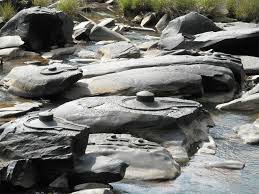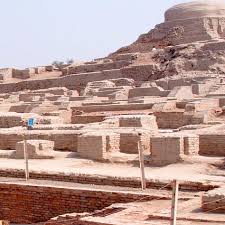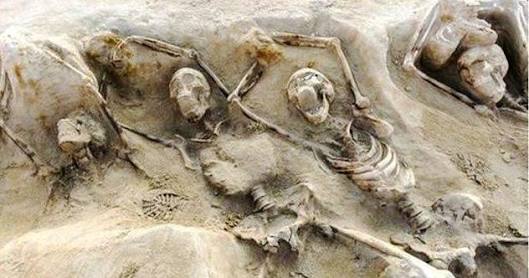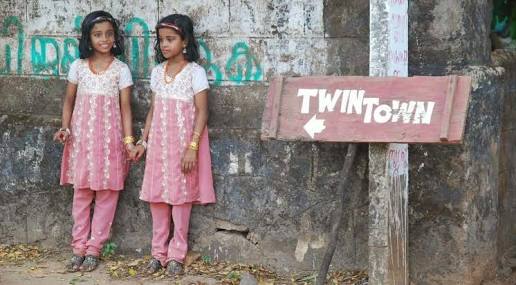Top 9 Most Famous Bizarre Discoveries In India
- First Case Leprosy: The skeleton of the earliest case of leprosy was found in India in 2009. The skeleton is more than 4,000 years old and it may give archaeologists a clue about the early outbreak of the disease. Leprosy is still not widely understood because of the deterioration of the bacterial cells that caused the infection. Despite popular opinion leprosy actually doesn't cause limb loss. It is the appearance of large skin lesions and the disease is not easily spread. Leprosy was one of the great plagues of history and the infected were often cut out from society because of the disease. While the disease is curable now it was a large problem in ancient times. Two theories exist about the spread it was transferred out of Africa by early humans or the disease originated in India. When the first cities were developed lack of Hygiene would have been the main cause of the infection.
- Shalmala River:
.jpg)
This incredible discovery was made in 1969. It's a river located Karnataka State India and as thousands of Shiva lingam stones found at the bottom of a lake. A Lingam is a Hindu altar for the deity Shiva the stones can be seen when the water of the lake drops low enough. The stones feature many male and female representations and also of Nandi the gods bull mount. The place has been named Sahasra Linga and it is a popular pilgrimage place for Hindus. The name Sahasra Linga actually means a thousand Lingas in Sanskrit the Lincoln's are believed to have been placed there by the order of Sadashiva Raya the ruler during 1678 through 1718. It is believed that he did this so that God would bless him with an air.
- Extinct Tree Frog:

This little guy was rediscovered by an amphibian researcher named Satya bomba that's BG. The frog in question was thought to have been extinct since 1870. A rare tree frog lives in the air and that fact might have aided the frog in its grand disappearance. The discovery brings with it the hope that more of the frogs might be found over China and Thailand. The recent studies by experts have caused the Frog to be classified in a whole new genus. Another factor in it being undiscovered is the remote location on which it was found. The discovery was even made by accident by Dr. Bujji while he was searching for different frogs. A former name of the Frog was Polly PTH Giordani and the new name is Frankie's, Alice Giordani. However Dr. Bijou warns that the frogs are in danger due to deforestation.
- Kalibangan:
.jpg)
Is one of the few known prehistoric cities. The city was the center of an ancient Indus Valley Civilisation. The site hints that the birth of farming with evidence of plowed fields. The houses and structures of the city are made of hard dried mud bricks. According to archaeologists, the city dates back to 3500 to 2500 BCE. With the city being abandoned between 2,500 and 1750 BCE. Jewelry and Weapons were also found among the remains there is also evidence of an earthquake in the area around 2600 BCE. Which caused the death of much of the citizens in the area. when another interesting find is fire altars.
- Dholavira:

Are an archaeological site and you generate estate in western India it is one of the biggest archaeological sites in India and was part of the Indus Valley civilizations. It is the fifth largest of remaining Indus Valley cities. It was rediscovered in 1968 and it's remarkable because of the innovations present in the city that were made way before its time. The architecture is almost more advanced than ours mathematically speaking of course. One of the remarkable features of the city is its reservoirs contained in the city is one of the earliest signs of that type of technology. They stored rainwater in defense of the dry climate of the location. The city also contained a wealth of artistic remnants. That has since been restored.
- Ancient Skeletons:
.jpg)
In 2015 a group of Indian archaeologists found a group of skeletons dating back to the Indus Valley Civilisation. Thought to be one of the earliest civilizations the Indus Valley Civilization emerged over 5000 years ago and was located in Pakistan India and part of Afghanistan. The skeletons appear to be the remains of a family of three. the team that discovered the skeletons had been working at the site since 2012. It is believed that the remains will provide insights into early human life and development along with the remains toys and figures were discovered. Archaeologists believe that the placement of the object might mean that the ancient civilizations believed in reincarnation.
- Sanchi Stupa:
.jpg)
Sanchi is the oldest stone structure in India it was the central location for Buddhist India for several centuries. After Buddhists lost the prevalence that it once had in India the temple was abandoned. However, it was rediscovered in 1881 by a British soldier. The structure was made by the order of the Emperor Ashoka the great around the 3rd century BC. Although commissioned by the Emperor his wife Devi actually oversaw the construction. The temple still remains the largest Buddhist center in India.
- Twin Village:
.jpg)
Good Indy village is a village in Kerala India it is more well known for its nickname twin village. It's gained its name from the unusually high occurrence of twin births. As of 2008, the village contained 2,000 families and among the citizens were about 250 twins. Although India has one of the lowest rates of twin births the multiple birth rate in this village is very high. an association of twins was founded in the city called the twins and kins Association. Scientists have no explanation for the recurrence of these births women who moved away from the village are also known to give birth to twins. Doctors believe the occurrence is caused by chemicals in the water supply there are currently 79 pairs of twins 10 and under in the village.
- Deur Kothar
 : Deur Kothar was discovered in 1982. It is located in Madhya Pradesh Central India. The Buddhist temple is known for its stupas or dome-shaped structures the government of India named the location a monument of national importance in 1988 and it has since been preserved by Archaeological Survey of India. The location has since been ongoingly excavated due to its importance of the Buddhist religion. The existence of certain relics such as toys jewelry and coins hint that this was once a trade location in ancient India. The location also contained old rock paintings and sheds light on the life and technology of past people.
: Deur Kothar was discovered in 1982. It is located in Madhya Pradesh Central India. The Buddhist temple is known for its stupas or dome-shaped structures the government of India named the location a monument of national importance in 1988 and it has since been preserved by Archaeological Survey of India. The location has since been ongoingly excavated due to its importance of the Buddhist religion. The existence of certain relics such as toys jewelry and coins hint that this was once a trade location in ancient India. The location also contained old rock paintings and sheds light on the life and technology of past people.
Congratulations @indianpictures! You have completed some achievement on Steemit and have been rewarded with new badge(s) :
Click on any badge to view your own Board of Honor on SteemitBoard.
For more information about SteemitBoard, click here
If you no longer want to receive notifications, reply to this comment with the word
STOPDownvoting a post can decrease pending rewards and make it less visible. Common reasons:
Submit